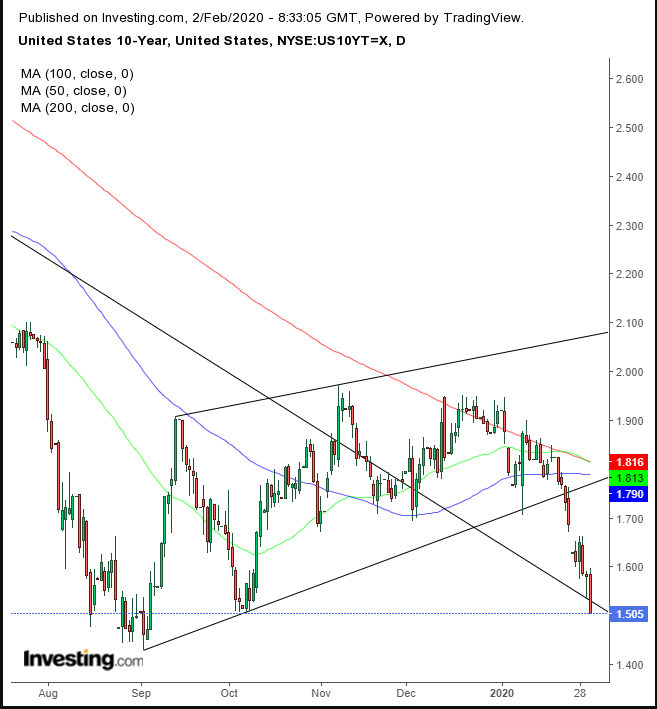All U.S. equity index gains for 2020 were wiped out on Friday, eviscerated by fears the still uncontained coronavirus could have a greater than expected impact on the global economy. The four major indices—the Dow Jones, S&P 500, NASDAQ and Russell 2000—suffered their worst weekly performances since October.
Not surprising then that safe havens gold, the Japanese yen and Treasurys all gained as trading for the month of January came to a close. With the pandemic continuing to spread, along with the growing number of fatalities, we expect considerable risk-asset volatility in the week ahead.
Mega Caps and Small Caps Underperform
Though China’s steps to check the spread of the deadly virus initially reassured investors—boosting markets early last week—the contagion continued spreading, growing to more than 14,000 confirmed cases currently, along with the first death outside of China, in the Philippines, bringing the total number of fatalities to 304 as of Saturday. On Thursday the World Health Organization declared the Wuhan virus an official public health emergency of international concern.
Separately, as expected, the U.S. Federal Reserve left interest rates unchanged, while expressing dissatisfaction with inflation missing the 2% target. Still, the U.S.'s Q4 GDP grew 2.1% though Consumer spending fell. Residential fixed investments and government spending increased, and the trade deficit narrowed, supporting the economy.
During the final day of trade last week, U.S. equities sold off sharply. Both ends of the equity spectrum—mega caps and small caps—underperformed, each losing approximately 2% of value. The Dow tumbled more than 600 points.
It was the second consecutive weekly loss for U.S. stocks, wiping out all of January’s advances, on concerns that travel restrictions into and out of China as well as the virus's impact on trade would cut off global growth at the knees, just when it was showing signs of a recovery.

From a technical perspective, the S&P 500 fell below its uptrend line since the Oct. 3 bottom. The MACD and RSI turned bearish, suggesting the 50 DMA will give way and prices might retest the November highs at the 3,100 levels.

Yields on the 10-year Treasury note fell to 1.50, the lowest since Sept. 4. A drop below 1.45 will be the lowest level for yields since July 2016. Technically, rates fell back below the downtrend line since the November 2018 top and the 50 DMA inched back below the 200 DMA, as a potential golden cross turns bearish.

The U.S. Dollar Index plummeted on Friday, falling 0.5%, back below the major MAs but finding support by the broken downtrend line.

The yen, in turn, strengthened, rising over 0.5% vs the dollar. The USD/JPY found support by the 200 DMA and the uptrend line since the late-August bottom.
Gold climbed to $1,595.13, its highest price since Jan. 7, though it closed lower, at $1,587.90. When it closes at the early January level, it will be the highest point for the precious metal since March 2013.
While we have been cautious overall due to the repeated new record highs on cheap money, we actually don’t believe the virus itself will have a long-lasting impact on markets. We do however expect considerable volatility in the near-term on shifting news, creating dramatic buying dips, with smart money taking advantage of any temporary setbacks.
On the other hand, the “godfather of technical analysts,” Ralph Acampora, expects the downturn to sharpen to at least 10%, possibly a bit more. However, said Acampora:
“I’m not negative [on the stock market], if you’ve got cash and are looking to get in this [market], this is an opportunity.”
The Week Ahead
All times listed are EST
Sunday
20:45: China – Caixin Manufacturing PMI: expected to decline slightly, to 51.3 from 51.5.
Monday
3:55: Germany – Manufacturing PMI: seen to rise to 45.2 from 43.7, though still well below expansion levels.
4:30: UK – Manufacturing PMI: likely remained flat at 49.8.
10:00: U.S. – ISM Manufacturing PMI: projected to advance to 48.5 from 47.2, still below 50.00 minimum for expansion.
22:30: Australia – RBA Interest Rate Decision: forecast to remain at 0.75%.
Tuesday
4:30: UK – Construction PMI: probably climbed to 46.0 from 44.4, not yet enough to be considered expansion territory.
Wednesday
8:15: U.S. – ADP Nonfarm Employment Change: seen to drop to 159K from 202K the month previous.
10:00: U.S. – ISM Non-Manufacturing PMI: likely edged higher, to 55.1 from 55.0.
10:30: U.S. – Crude Oil Inventories: came in last week at a higher than expected 3.548M bbls.
Friday
5:30: Russia – Interest Rate Decision: forecast to ease to 6.00% from 6.25%.
8:30: U.S. – Nonfarm Payrolls: expected to have grown to 161K new jobs created in January, from 145K in December.
8:30: U.S. – Unemployment Rate: seen to remain in record low territory, at 3.5%.
